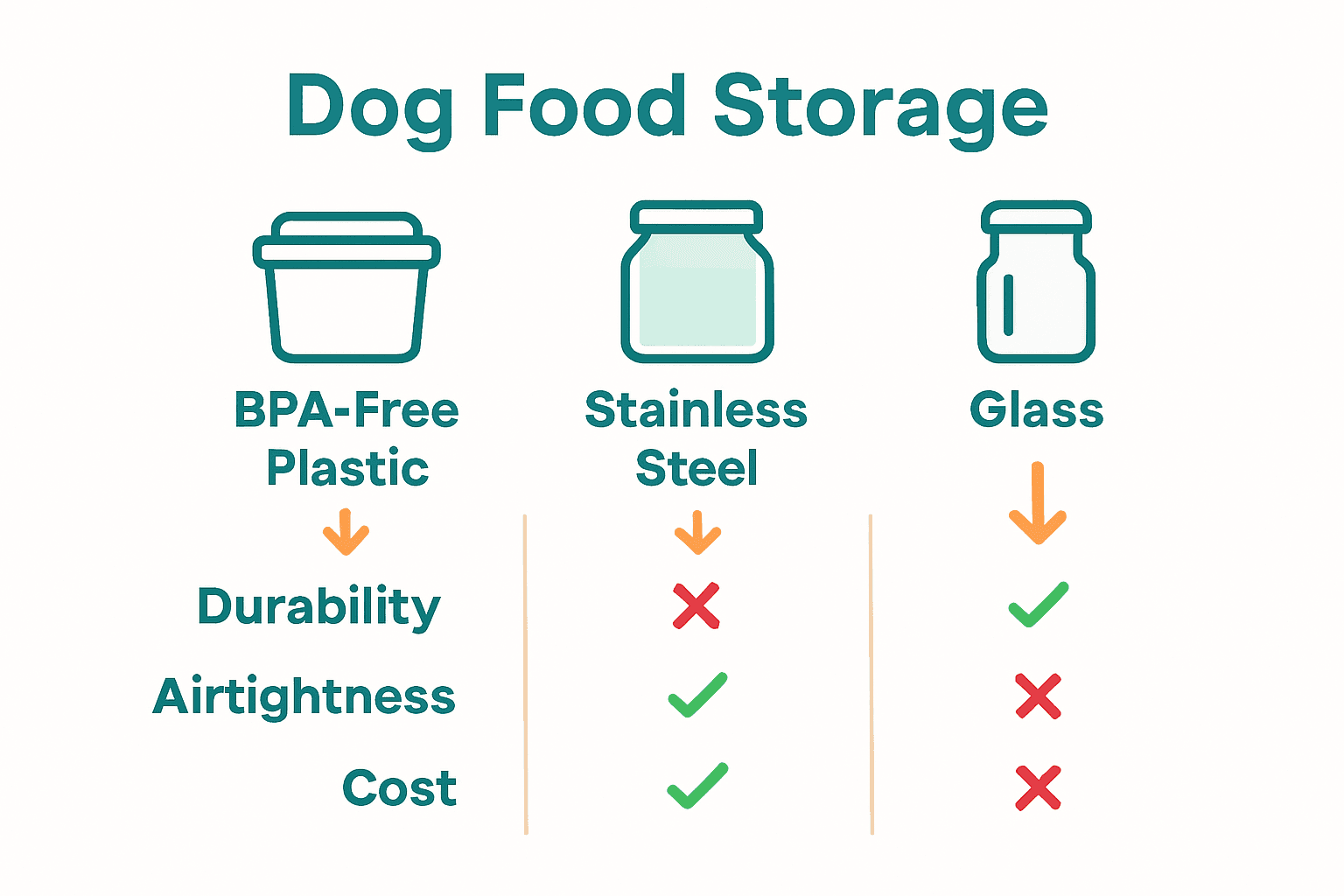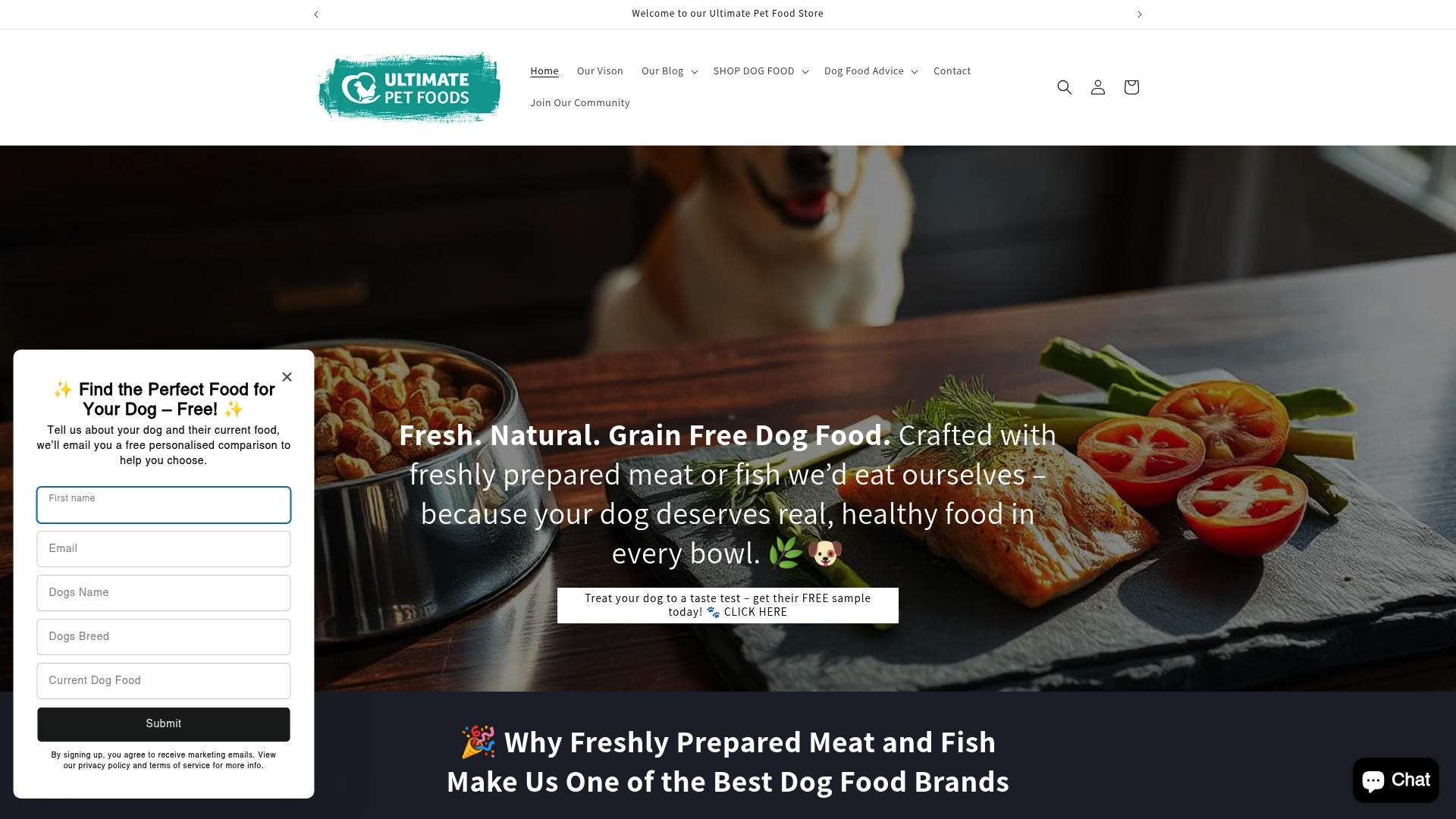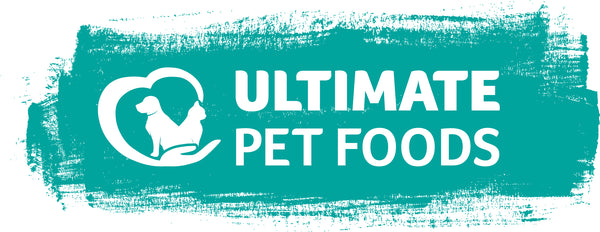
How to Store Dog Food Naturally for Freshness and Safety
Share
Did you know that improper storage can cause up to 40% of commercial dog food to lose its nutritional value before it ever reaches your pet’s bowl? Choosing the right storage methods does more than preserve flavor, it protects your dog’s health and prevents costly food waste. With smart choices and a few simple habits, you can keep your dog’s meals safe, fresh, and full of the nutrients they need every day.
Table of Contents
- Step 1: Select The Right Storage Containers
- Step 2: Prepare Your Storage Area For Pet Food
- Step 3: Transfer Dog Food Safely And Hygienically
- Step 4: Seal And Store Dog Food In Optimal Conditions
- Step 5: Check Dog Food Freshness Regularly
Quick Summary
| Key Point | Explanation |
|---|---|
| 1. Choose dedicated storage containers | Use containers designed for pet food to avoid cross-contamination and ensure food safety. |
| 2. Maintain a clean storage area | Store dog food in a cool, dry place away from chemicals and direct sunlight to preserve quality. |
| 3. Handle food hygienically during transfer | Always wash hands and use clean utensils to prevent bacterial contamination when transferring food. |
| 4. Seal containers tightly | Ensure containers are airtight to keep food fresh and free from moisture or air degradation. |
| 5. Regularly check food freshness | Inspect dog food weekly for signs of spoilage or changes in texture, smell, or appearance. |
Step 1: Select the Right Storage Containers
Choosing the perfect storage container for your dog’s food is more than just grabbing any old box from the kitchen. According to UK government guidelines, you need a dedicated container specifically designed to prevent cross contamination and maintain food safety.
Start by selecting a container that is completely leak proof and made from food grade materials like BPA free plastic or stainless steel. These materials prevent moisture and potential bacterial growth while keeping your dog’s kibble fresh. As the UK government recommends, the container should be easy to clean and disinfect after each use.
Here’s a comparison of common storage container materials for dog food:
| Material | Advantages | Disadvantages |
|---|---|---|
| BPA-free Plastic | Lightweight Affordable Airtight options available |
Can absorb odours May scratch over time |
| Stainless Steel | Durable Resistant to odours and stains Easy to clean |
Usually more costly Heavier |
| Glass | Non-porous No chemical leaching See contents easily |
Fragile Heavy Often not airtight |
Look for containers with tight sealing lids that create an airtight environment.

This prevents moisture and air from degrading the nutritional quality of the food. Some excellent features to seek include:
- Built in measuring cups
- Clear markings to track food quantity
- Wide mouth openings for easy filling
- Stackable design to save kitchen space
Pro tip: Invest in multiple smaller containers rather than one large container. This allows you to rotate stock and ensure you are always serving the freshest possible food to your furry friend.
Next up, we will explore how to properly clean and maintain these storage containers to keep your dog’s food safe and delicious.
Step 2: Prepare Your Storage Area for Pet Food
Creating a safe and hygienic storage area for your dog’s food is crucial for maintaining its nutritional quality and preventing potential health risks. According to local UK Trading Standards guidance, the right storage environment can significantly reduce spoilage and contamination.
First, select a dedicated storage space that is cool, dry, and away from direct sunlight. As recommended by UK government guidelines, this area should be completely separate from household chemicals and food preparation zones. Ensure the space has good ventilation and maintains a consistent temperature to preserve the food’s integrity.
Key considerations for your pet food storage area include:
- Clean surfaces free from dust and debris
- Sufficient spacing between food containers
- Protection from potential pest access

- Temperature controlled environment
Implement a regular cleaning routine that involves wiping down shelves, checking for any signs of moisture, and maintaining overall cleanliness. For those interested in understanding proper pet nutrition transitions, creating an optimal storage environment is the first step towards ensuring your dog’s dietary health.
Warning: Never store pet food near cleaning products, pesticides, or other potentially harmful chemicals that could contaminate the food or attract unwanted pests.
With your storage area prepared, you are now ready to move on to understanding the best methods for storing your dog’s food to maintain its freshness and nutritional value.
Step 3: Transfer Dog Food Safely and Hygienically
Transferring your dog’s food requires more than simply dumping kibble from one container to another. According to UK government guidance, proper handling is critical to preventing potential bacterial contamination and ensuring your pet’s health.
Begin by thoroughly washing your hands with soap and hot water before touching any pet food containers. As recommended by official health guidelines, use dedicated clean utensils specifically for pet food transfer. Avoid using kitchen utensils or surfaces that might introduce cross contamination.
Key steps for safe food transfer include:
- Clean all transfer surfaces before use
- Use designated scoops or measuring tools
- Handle food quickly to prevent exposure to room temperature
- Wash hands immediately after handling
For pet owners looking to understand optimal nutrition strategies, maintaining strict hygiene during food transfer is fundamental. Always pour new food on top of remaining food in the container to ensure older stock gets used first and minimise waste.
Warning: Never mix old and new batches of dog food from different manufacturing dates, as this could introduce potential bacterial risks.
With your food safely transferred, you are now ready to monitor and maintain its quality throughout storage.
Step 4: Seal and Store Dog Food in Optimal Conditions
Storing your dog’s food correctly is crucial for maintaining its nutritional value and preventing spoilage. According to UK government guidelines, proper storage goes beyond simply closing a bag it requires careful attention to environmental conditions and handling techniques.
Start by ensuring your food container has an airtight seal that prevents moisture and air from degrading the food quality. Government recommendations emphasise keeping storage areas clean dry and well ventilated. For dry kibble this means maintaining a consistent cool temperature away from direct sunlight and humidity.
Key storage strategies include:
- Keep original packaging inside the sealed container
- Record the date of opening
- Store in temperatures below 26 degrees Celsius
- Keep away from direct light and heat sources
For pet owners wanting to learn more about choosing optimal nutrition, understanding proper storage is fundamental. Raw or wet foods require additional precautions like refrigeration or freezing to prevent bacterial growth.
Warning: Always discard dog food that shows signs of moisture mould or unusual odour as these indicate potential contamination.
With your dog food properly sealed and stored you are now ready to maintain its freshness and nutritional integrity throughout its shelf life.
Step 5: Check Dog Food Freshness Regularly
Maintaining the quality of your dog’s food requires consistent monitoring and vigilant inspection. According to UK government guidance tracking the condition of pet food is crucial for preventing potential health risks and ensuring optimal nutrition.
Establish a regular inspection routine that involves examining your dog food at least once per week. Look for telltale signs of spoilage including unusual odours changes in colour or texture and the presence of moisture or mould. Government recommendations emphasise disposing of any food that shows signs of degradation as soon as possible.
Key freshness assessment strategies include:
- Check expiration dates on packaging
- Inspect container seals for potential damage
- Smell test the food for rancid or off odours
- Look for discolouration or clumping
For pet owners eager to understand more about fresh dog food benefits, recognising food quality indicators is fundamental to your pet’s health. Different food types require different storage approaches raw foods are particularly sensitive and need more frequent checks.
Warning: Never feed your dog food that appears compromised even if it seems minimally affected. The risk of bacterial contamination is too high.
With your food quality confirmed you can confidently continue providing safe nutritious meals for your furry companion.
Keep Your Dog’s Food Fresh and Naturally Safe
Storing dog food properly is essential to keep your pet healthy and happy. This article highlights the challenges of preventing contamination and maintaining freshness by using airtight, food-grade containers and a clean storage area. Many dog owners struggle with moisture, pests, and food spoilage, risking their furry friend’s nutrition and well-being. At Ultimate Pet Foods, we understand these concerns and offer premium natural options that complement safe storage practices perfectly.

Discover our range of Salmon Dog Food – Premium, Healthy, Hypoallergenic & Omega-Rich and Chicken Dog Food : Healthy & Natural designed with fresh, grain-free ingredients that support longer shelf life and nutritional integrity when stored correctly. Start with a sample from All Our Dog Food Samples – Ultimate Pet Foods to see how quality food combined with proper storage transforms your dog’s meals. Visit ultimatepetfoods.co.uk now to provide your dog with the freshest natural diet they deserve and ensure every mealtime is safe and nourishing.
Frequently Asked Questions
How should I select the right storage container for dog food?
Choosing the right storage container involves selecting one that is airtight and made from food-grade materials like BPA-free plastic or stainless steel. Look for containers with tight-sealing lids and features like measuring cups or wide mouth openings to make the storage process easier.
What are the best conditions for storing dog food?
Store your dog’s food in a cool, dry place away from direct sunlight and household chemicals. Aim to maintain a consistent temperature below 26 degrees Celsius in the storage area to preserve the food’s nutritional integrity and prevent spoilage.
How can I safely transfer dog food into a storage container?
To transfer dog food safely, wash your hands and use dedicated utensils that are clean and designated for pet food only. Ensure all surfaces are clean before the transfer to minimize the risk of contamination, and handle the food quickly to avoid exposure to room temperature.
How can I check if my dog’s food is still fresh?
Regularly inspect your dog food at least once a week for any signs of spoilage, such as unusual odors or discoloration. Dispose of any food that appears compromised, even if it seems minimally affected, to ensure your dog’s health is not at risk.
Why is it important to keep dog food sealed and stored properly?
Proper sealing and storage of dog food are crucial for limiting exposure to moisture and air, which can degrade quality and nutritional value. Ensure your container provides a tight seal and keep the original packaging inside; this will help maintain freshness and safety over time.
What should I do if I find signs of moisture or mold in the dog food?
Immediately discard any dog food showing signs of moisture, mold, or unusual odors, as these indicate potential contamination. It’s better to be safe than risk your dog’s health, so ensure to check for these signs regularly.
Recommended
- Understanding the Benefits of Fresh Dog Food for Your Pet – Ultimate Pet Foods
- Understanding Natural Dog Food Ingredients for Healthier Pets – Ultimate Pet Foods
- Wholesome Dog Friendly Recipes for Happy Pups – Ultimate Pet Foods
- 7 Key Insights on Dog Food Recalls 2025 Every Owner Should Know – Ultimate Pet Foods
- Store-Bought to Homemade Baby Food: Safe Transition Guide | Parent Kitchen Lab
- Baby Food Storage Guide: Portioning Homemade Purees | Parent Kitchen Lab
